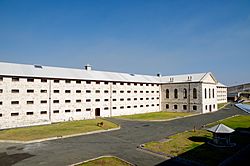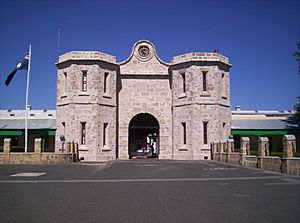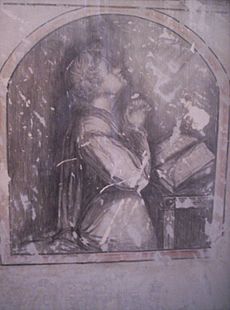Fremantle Prison facts for kids

Main Cell Block
|
|
| Location | Fremantle, Western Australia |
|---|---|
| Coordinates | 32°3′18″S 115°45′13″E / 32.05500°S 115.75361°E |
| Status | Closed; heritage site |
| Security class | Maximum |
| Opened | 1855 |
| Closed | 30 November 1991 |
| Managed by | Department of Planning, Lands and Heritage |
| Street address | 1 The Terrace |
| Type: | Cultural |
| Criteria: | iv, vi |
| Designated: | 2010 (34th session) |
| Part of: | Australian Convict Sites |
| Reference #: | 1306 |
| State Party: | Australia |
| Region: | Asia-Pacific |
| Type: | State Registered Place |
| Designated: | 30 June 1995 |
| Reference #: | 1014 |
Fremantle Prison, sometimes referred to as Fremantle Gaol or Fremantle Jail, is a former Australian prison and World Heritage Site in Fremantle, Western Australia. The six-hectare (15-acre) site includes the prison cellblocks, gatehouse, perimeter walls, cottages, and tunnels. It was initially used for convicts transported from Britain, but was transferred to the colonial government in 1886 for use for locally-sentenced prisoners. Royal Commissions were held in 1898 and 1911, and instigated some reform to the prison system, but significant changes did not begin until the 1960s. The government department in charge of the prison underwent several reorganisations in the 1970s and 1980s, but the culture of Fremantle Prison was resistant to change. Growing prisoner discontent culminated in a 1988 riot with guards taken hostage, and a fire that caused $1.8 million worth of damage. The prison closed in 1991, replaced by the new maximum-security Casuarina Prison.
The prison was administered by a comptroller general, sheriff, or director, responsible for the entire convict or prison system in Western Australia, and a superintendent in charge of the prison itself. Prison officers, known as warders in the 19th century, worked under stringent conditions until they achieved representation through the Western Australian Prison Officers' Union. Convicts were initially of good character as potential future colonists, but less desirable convicts were eventually sent. As a locally-run prison, Fremantle's population was generally short-sentenced white prisoners in the 1890s, with very few Aboriginal prisoners. By the late 20th century, most prisoners were serving longer sentences, a higher proportion of them were violent, and Aboriginal people were over-represented.
Prison life at Fremantle was extremely regulated. Meals were an important part of the day, eaten in the cells throughout the operational life of the prison. Convict or prisoner labour was used on public infrastructure works until around 1911; subsequently, only work inside the prison was allowed, though there was never enough to fully occupy the inmates. Punishments varied over the years, with flogging and time in irons eventually replaced by lengthening of sentences and deprivation of visitors or entertainment.
Since 1991, Fremantle Prison has been conserved as a recognised heritage site, and various restoration works have been undertaken. New uses have been found for some buildings within the prison, which has also become a significant tourist attraction. The process of obtaining World Heritage listing as part of the Australian Convict Sites submission focused historical interpretation and conservation efforts on the prison's convict era (1850 – 1886), at the expense of its more recent history, including Aboriginal prisoners held there.
Conservation
Heritage listing
Fremantle Prison was listed in the Western Australian Register of Historic Places as an interim entry on 10 January 1992 and included as a permanent entry on 30 June 1995. Described as the best preserved convict-built prison in the country, it became the first building in Western Australia to be listed on the Australian National Heritage List, in 2005. The Australian Federal Heritage Minister, Senator Ian Campbell, stated that it would be included in a nomination of eleven convict areas to become World Heritage Sites. Five years later, these locations were inscribed on the UNESCO World Heritage List in 2010 as the Australian Convict Sites.
The process of obtaining World Heritage listing focused historical interpretation and conservation efforts on the prison's convict era. This came at the expense of its more recent history, included use as an internment centre during World War II, and the imprisonment of Aboriginal prisoners. The prioritisation, evident from the first conservation plans from before the prison closed, is reflected in the branding of the tourist experience as "Fremantle Prison – the Convict Establishment", and through restorations that, while necessary to prevent damage and deterioration, strip away the site's recent history.
Restoration
Various parts of Fremantle Prison have had restoration works undertaken since the 1990s; a total of $800,000 was spent between 1996/97 and 1998/99 on works which included restoring the facade of the Anglican chapel. In 2005, work was undertaken on the restoration of the prison gatehouse area. Non-original rendering was removed and the original stonework was revealed. Work was also completed on the tunnels during 2005/06, and the main cell block was restored with an eighteen month, $1.9 million project in 2006 and 2007. The gallows room was restored in 2013 to conditions at the time of the last execution, in 1964.
Tourism
Fremantle Prison receives international and domestic tourists, as well as ex-prisoners, former prison officers, and their descendants. Tourist numbers increased each year from 2001/02 to 2009/10, up from almost 105,000 to nearly 180,000 over that period. As of 2018[update], the prison has won, been a finalist in, or received other commendation at tourism or heritage awards each year since 2006.
Attractions include guided tours, a visitors' centre with searchable convict database, art gallery, café, gift shop, and tourist accommodation. Educational activities are regularly held for school children, as are exhibitions and re-enactments of historical events. Functions such as theme parties and dinners are held in the prison, with re-enactments serving as entertainment. Tours of the prison show aspects of prison life and recount successful and attempted escapes. Sections of the tunnels are accessible, and night tours focus on the prison's reputation for being haunted.
The Fremantle Prison Collection contains around 15,000 items associated with the prison's site, history, or the experiences of its workers and prisoners. It is also involved in preserving oral histories, with interview transcripts stored at Fremantle Prison and recordings archived in the Battye Library Oral History Collection. Recollections have been recorded since 1989, and include the experiences of authorities, staff, volunteer visitors, and prisoners. The Fremantle Prison records and collections, including archaeological, provide a substantial resource for researchers.
The Prison Gallery showcases and offers for sale the artworks of current and ex-prisoners of Western Australia. It also hosts other exhibits related to the history of the prison, including historical artefacts. Many cells and areas of the prison depict prisoners' artwork, including that of the 19th-century forger James Walsh, whose artwork was hidden beneath layers of white-wash for decades. Painting or drawing on walls was originally forbidden, though graffiti, which could be viewed as art or vandalism, occurred throughout the prison's operational years. This rule was relaxed in special cases – including, from 1976, long-term prisoners within their own cells – but only for work considered art and not graffiti. Art, or art therapy, was not officially permitted until the 1980s; graffiti was never formally permitted, but in the prison's last six months, with closure imminent, the rule was not enforced.
Other cells contain Aboriginal artwork, many by unknown artists. The Walmajarri artist Jimmy Pike started painting in Fremantle prison, having received tuition from Steve Culley and David Wroth.
Images for kids
-
1859 watercolour of the Main Cell Block, by Henry Wray
See also
 In Spanish: Prisión de Fremantle para niños
In Spanish: Prisión de Fremantle para niños














